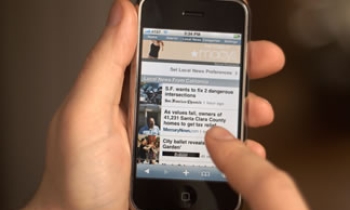WITH the fall comes the harvest. Or at least that’s what Richard D. Parsons and his top dogs at Time Warner have hoped for in autumns past. But regardless of how much the chief executive and his allies regroup, retool and reorganize their sprawling media empire, the stock market just yawns. Every morning when they look at Time Warner’s ticker, it’s Groundhog Day.
Carl C. Icahn seems to be the only investor with a modicum of enthusiasm for the stock. Last month, he disclosed plans to form a new fund to scoop up more Time Warner shares so he could add to the boatload he already owned. And, by the way, he basically wants to bust up the place.
For his part, Mr. Parsons spent last week vacationing on Block Island, R.I., no doubt aware of whispers that Time Warner, the world’s biggest media company, has a turbulent autumn ahead.
Here are just a few of the whispers: Will Mr. Parsons stick around as chief executive or pass the reins in the next few months to his No. 2, Jeffrey L. Bewkes? Will the latest strategy of its AOL business — offering its online service free to high-speed Internet users — take flight? Is the financial performance of its publishing unit, Time Inc., becoming a worrisome drag, and is it time to spin off its venerable fleet of magazines?
But are these or any other bold moves that Mr. Parsons might make, including a huge stock buyback, enough to lift Time Warner’s shares and to get Mr. Icahn off the company’s back? Let’s consider the rumors, and Mr. Parsons’ options, in sequence.
Nary a week goes by without speculation that Mr. Parsons, who is 58, is ready for a change of scenery — perhaps, à la New York magazine’s recent conjecture, to make a bid to be New York’s next mayor. Mr. Parsons has said that this is not his ambition, and confidants say he is far more interested in big-time federal jobs, like secretary of education — depending on who occupies the White House after the election in 2008, which happens to be the same year that his current Time Warner contract is up.
There is also the question of how long Mr. Bewkes, 54, will remain content to wait in the wings. Mr. Bewkes has shown no signs of impatience, and Mr. Parsons already gives him the broad mandate of a true partner, as illustrated by the recent AOL strategy shift he championed.
HERE’S what Edward I. Adler, Time Warner’s spokesman, told me last week: “Dick is working hard running Time Warner and is committed to continuing his current role at least until the end of his contract. He and Jeff Bewkes are making the tough decisions needed to move the company forward and create shareholder value.”
My read is that even if Mr. Parsons is enamored of public service, he wants to leave Time Warner on his own terms. Bowing to Mr. Icahn’s demands is clearly not part of that agenda. He can point to some bright spots, too: sweeping up the legal, regulatory and managerial debris that the Time Warner-AOL merger left behind, and efficiently presiding over some of the most profit-churning media brands, from Warner Brothers to HBO to People magazine to Time Warner Cable.
But going out on top probably means a stock price above $20 a share, a level the company has not hit since April 2002, the month before Mr. Parsons assumed the helm. On Friday, the shares closed at $16.76. If the stock doesn’t hit $20 by next year, it’s hard to imagine that Mr. Parsons will still be the chief executive. After all, media stocks are no longer uniformly in the doldrums: shares of Comcast, for instance, have risen 41 percent off their 52-week low, and the company now boasts a market capitalization of $74 billion, eclipsing Time Warner’s $68 billion.
(Such are the vicissitudes of the market: the News Corporation and Disney have also outperformed Time Warner of late. But if you owned Time Warner stock for at least a decade, it has actually wildly outperformed both of those companies and Comcast.)
In the near term, one possible financial lifeline is the planned public listing next year of Time Warner Cable. That unit is the cable industry’s second-largest player, after Comcast, and the flotation could serve to bottle the same lightning that has ignited Comcast stock.
But just as cable is gaining steam and AOL is on a new path, Time Inc. — the smallest of the company’s five major operating businesses — remains challenged. Time Inc.’s operating income dropped 11 percent, to $388 million, in the first half of the year, compared with the same period of 2005. Revenue was roughly flat, at $2.45 billion.
Mr. Parsons told me recently that an advertising slowdown at magazines favored by men and the rapid migration of ads from print to the Internet explained the drop-off in publishing profits.
Time Inc. has already undergone rounds of cost-lopping under its chief, Anne Moore, and moving Time magazine’s publication date to Friday from Monday is one small sign of how the division is trying to reinvigorate itself in the Internet era. Even so, Mr. Bewkes is seeking bigger structural changes at the division, according to several people close to the company. Mr. Bewkes has zeroed in on the fact that Time Inc. publishes some 145 magazines worldwide, yet its 10 biggest generate a vast majority of its revenue. Expect them to get the bulk of attention and resources while some smaller titles drop their print editions (as Teen People recently did) and others are sold.
It is unlikely, however that a whole-hog sale of Time Inc., or any other division, will happen on Mr. Parsons’ watch. He has steadfastly maintained — and Mr. Bewkes has concurred — that Time Warner still makes more sense intact than in pieces. They can point to the ho-hum results of splitting up Viacom and CBS as evidence. They may also feel a bit gun-shy, given that Warner Music, a division they sold to Edgar Bronfman Jr. and other investors in 2004 for $2.6 billion, now has a market capitalization of $3.7 billion.
The elephant in the room, of course, remains AOL. Is its new strategy to thrive on advertising revenue sound, or is it too late for AOL to muster the firepower needed to dominate on the Web, as it once did? If the answer to either question is no, you can’t help wondering if selling or merging AOL with another Web player is inevitable.
If it came to that, my money would be on Yahoo, which was rebuffed last winter when AOL was courting online partners.
AOL’s new business model resembles Yahoo’s more than that of any other company, and Yahoo’s chief executive, Terry S. Semel, was previously the co-head of the Warner Brothers film and TV studios. With Yahoo’s shares having fallen this year, there is less risk that Time Warner would deliver a repeat of the AOL merger fiasco by combining with another hyperinflated Internet company.
Finally, there is Mr. Icahn.
Mr. Parsons deftly handled Mr. Icahn’s well-publicized call for a breakup before the annual meeting earlier this year, getting the billionaire and his hedge fund partners to call off a proxy fight that was doomed. He could probably handle him again. But Mr. Icahn also learned some valuable lessons in his first run at Time Warner. He also takes pride in his ability to bide his time.
At the investor conference held by Mr. Icahn at the height of his campaign to dismember Time Warner last winter, he boasted that it took him years to persuade RJR Nabisco to split itself up. “I am a rite of spring. And every spring, we’d come and have a little proxy fight,” he recalled.
I asked him whether this meant that if he didn’t gain seats on Time Warner’s board, he’d simply come calling again. He replied that Time Warner was different from a food and tobacco company because the media industry was changing so rapidly: “I don’t think there’s a great deal more time if we miss this one.”
Yet here we are, a half-year later, and he is looking to buy more stock. A poor harvest this fall could lead to a bleak winter. And, with the spring, comes Mr. Icahn.









